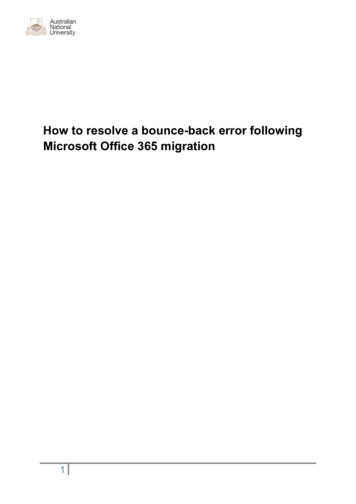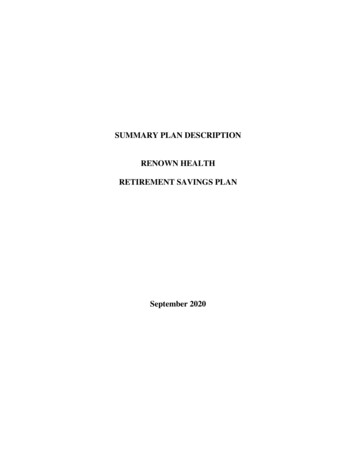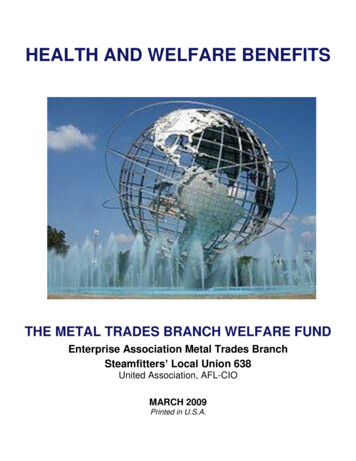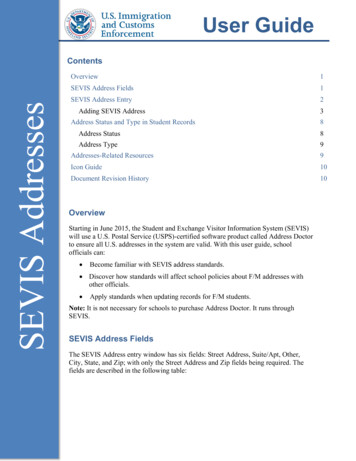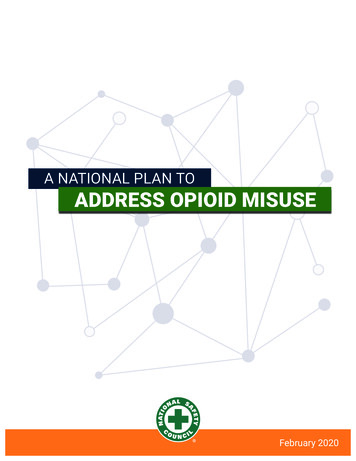
Transcription
A NATIONAL PLAN TOADDRESS OPIOID MISUSEFebruary 2020
In partnership with:Authored by:2525 FoundationThe Ad CouncilAdvocates for Opioid RecoveryAmerican Association for Psychoanalysis in Clinical Social WorkAmerican College of Occupational and Environmental MedicineAmerican College of Osteopathic Emergency PhysiciansArizona Chapter of the National Safety CouncilArchitectural Wall Systems, Inc.Brady’s HopeCalifornia Consortium of Addiction Programs & Professionals(CCAPP)Captive ResourcesChesapeake Region Safety CouncilCitizens for Effective Opioid TreatmentConnecticut Certification BoardCory’s CauseDavis Direction FoundationDisposeRxFirmenichFletcher GroupFOA Families of AddictsHouston Area Safety CouncilInternational Certification & Reciprocity Consortium (IC&RC)Iowa-Illinois Safety CouncilLaborers' Health & Safety Fund of North AmericaLiver Health InitiativeLTM FoundationMatt Adams FoundationMinnesota Safety CouncilNational Association for Behavioral HealthcareNational Health Care for the Homeless CouncilNational Safety Council ArkLaTex ChapterNational Safety Council, NebraskaNational Safety Council of Northern New EnglandNational Safety Council Ohio ChapterNorth Dakota Safety CouncilNortheastern New York Safety and Health CouncilOklahoma Safety CouncilOperation RXParkdale Center for ProfessionalsRenown HealthStudents Against Destructive Decisions (SADD)Safe States AllianceSafety and Health Council of North CarolinaSafety Council of Western New EnglandSave the Michaels of the WorldSeedorff Masonry, Inc.Seedorff Masonry Industries CompanyShatterproofSociety for Public Health EducationSouth Dakota Safety CouncilSoutheastern Chapter – National Safety CouncilSouthwest AirlinesStericycleTennessee Safety and Health CouncilThe Kennedy ForumU.S. SteelUtah Safety CouncilWisconsin Safety CouncilWyoming-Montana Safety Council
A NATIONAL PLAN FOR ADDRESSING OPIOID MISUSEFor the first time in U.S. history, a person’s lifetime odds of dying from an accidental opioid overdose (1 in 96) haveeclipsed the odds of dying from a motor vehicle crash (1 in 103). The opioid crisis takes more than 130 lives each dayand requires a coordinated, immediate response from various stakeholders, including federal and state governments,public health agencies, health and safety organizations, community-based organizations and non-profits, youth-focusedorganizations, medical professionals and centers, employers, and an educated public willing to advocate its ownmedical decisions.The National Safety Council has assembled a comprehensive plan – endorsed by the organizations listed on page 2of this paper – that any candidate for President of the United States could adopt to ensure opioid misuse in the U.S.is addressed thoroughly, thoughtfully and effectively. The organizations supporting this plan urge all presidentialcandidates to examine their existing strategies and close gaps, or adopt this plan in full for the safety and wellbeing ofthe constituents they are vying to represent and protect.These needs and actions are intertwined and interdependent – one tactic cannot be effective without another. Therecommendations in this plan are laid out based on the life cycle of addiction – from inception to recovery – and takeinto account societal factors and influences such as employment, data collection, enforcement and pharmaceuticallitigation. We must ensure targeted, appropriate and sensitive interventions throughout the life cycle of opioid use andmisuse are designed, implemented and evaluated.PREVENTION EFFORTS Expand and enhance research and development of evidence-based prevention programs Screen upon prescribing for familial or individual history of addiction and substance use disorders (SUDs) Develop early intervention programs, such as Screening, Brief Intervention, and Referral to Treatment (SBIRT)and other evidence-based interventions Expand drug take-back programs to include safe disposal sites at pharmacies, police stations and municipalbuildings, and increase the presence of secure, free-standing drop-boxes in the community Expand access to in-home drug deactivation and disposal technologiesReduce the availability and supply of illicit drugs in the U.S. Disrupt, dismantle and defeat drug traffickers and their supply chains Work with international partners Combat illicit internet drug sales Focus federal government efforts against illicit drug delivery through the mail and expressconsignment networks Interdict the flow of drugs across physical borders and into the U.S. Disrupt and dismantle the illicit drug production infrastructure Leverage the full capabilities of multi-jurisdictional task force programs Enhance law enforcement capacitySee “Prescriber and Medical Community Efforts” for detailed strategies for addressing prescriber's role in reducingsupply and enhancing prevention efforts3
PUBLIC EDUCATION AND STIGMA REDUCTION EFFORTS Enhance understanding of how community, environmental and individual factors as well as other socialdeterminants of health increase the risk of developing a substance use disorder and impact its treatment. Someof these complicating factors and circumstances include: Socio-economic statusMental health conditionsPeople who have experienced trauma (including Adverse Childhood Experiences [ACEs])WomenLGBTQ peoplePeople of colorNative AmericansVeteransRural AmericansIncarcerated persons Increase accessibility of evidence-based, youth- and teen-focused education initiatives and interventions Support organizations launching public education campaigns aimed at increasing understanding of the risksof opioids and how to ask prescribers for alternatives Increase awareness of the myriad impacts the opioid crisis has on families, their experiences andfamilial structure Initiate actions to reduce stigma, including increasing education and altering language to remove derogatory,stigmatizing and judgmental words and phrases Implement contact-based strategies – messaging between people with substance use disorders, people inrecovery and those without substance use disorders – when possible, humanizing the disorder and emphasizingtreatment effectiveness Normalize recovery in public discourse through a nationwide public education campaign elevating survivorsof substance use disorders Publicly recognize institutions for implementing actions that reduce stigma Increase research on stigmaPRESCRIBER AND MEDICAL COMMUNITY EFFORTS Address the role prescribers and prescribing play in the opioid crisis: Mandate use of Prescription Drug Monitoring Programs (PDMP) Continue to assess and evaluate long-term impacts of PDMPs on the opioid crisis; ensure PDMPuse and best practice evolves accordingly Mandate prescriber education on opioids and their use for acute and chronic pain Mandate addiction education for medical professionals who write prescriptions Continue to evaluate and update prescriber guidelines, including the CDC Guideline for Prescribing Opioidsfor Chronic Pain, and standardize use for anyone who prescribes opioids Ensure individuals with chronic pain for whom usage of opioids is the appropriate pharmacotherapyare not denied access to these medications, and that accompanying risks are mitigated as much as possibleIncrease research on pain and addiction Enhance research into non-opioid pain management methods for both acute and chronic pain(See “Treatment Efforts” for detailed research suggestions) Improve training and education of the non-addiction specialist medical workforce – including but not limited toprimary care, emergency department, acute care and mental health professionals – on addiction science andassessing for substance use disorders4
HARM REDUCTION EFFORTS Expand and enhance research and development of evidence-based harm reduction services and programs,including but not limited to: Syringe exchange services Community-based take-home naloxone distribution programs for people who use opioids Supportive housing and other services built on harm reduction philosophies for people living with addictionNALOXONE EFFORTS Expand and enhance research and development of evidence-based naloxone education and distributionprograms, prioritizing people at highest risk of experiencing or witnessing an opioid overdose Ensure every state has comprehensive Good Samaritan laws in place to protect people who use naloxone totreat someone suspected of overdosing from negative legal consequences, regardless of legal status Support community-based take-home naloxone distribution programs for people who use opioidsEnsure naloxone is covered by insurance co-pays Make naloxone available with every opioid prescription received at a pharmacy Expand access to naloxone to the above groups, first responders and other community members and settings –including entities such as libraries, hotels and public transit stations, among others – with higher incidenceof opioid overdose Support education campaigns for the general public to recognize signs and symptoms of an opioid overdose,“and understand how to access and use naloxoneEMPLOYER EFFORTS Urge employers to enhance existing drug-free workplace policies to include policies for employees with opioiduse and other substance use disorders so they can, among other strategies: Support employees to return to work during and following treatment Have the flexibility to accommodate employees who are prescribed opioids Urge employers to educate supervisors and managers about the signs of opioid misuse so employers can spotearly symptoms Ensure all workplaces have naloxone on-site and that emergency response staff members are trained on howto administer it Expand Employee Assistance Programs (EAP) to provide barrier-free preventive services, screening andearly identification services, short-term counseling, referral to specialty treatment and other behavioralhealth interventions related to opioid use and misuse Expand insurance plans to ensure coverage of non-opioid pain treatment options, including but not limited tonon-opioid pharmacology, physical and occupational therapy. Ensure coverage of evidence-based treatmentfor opioid use disorders and address other disparities and gaps in healthcare benefits. Support a stigma-free, recovery-friendly workplace culture5
DATA COLLECTION EFFORTS Require states to screen for and identify all drugs present in overdose fatalities Require hospitals, EMTs, law enforcement, coroners and medical examiners to promptly report drug overdoses tothe appropriate jurisdictional authority or authorities Require said jurisdictional authority to report out on data points, including but not limited to drugs presentduring toxicology screen, de-identified demographic data and other points as determinedExpand and enhance reporting on non-fatal opioid overdoses Support and expand capacity at state and local public health laboratories to detect and identify opioids andnovel fentanyl analogues associated with non-fatal overdoses with the aim of informing and maximizing theimpact of public health interventions Require hospitals, EMTs, law enforcement, coroners, medical examiners and other entities to promptly reportnon-fatal drug overdose reversals to the appropriate jurisdictional authorityExpand and enhance other reporting systems such as those developed by the CDC, HHS, CMS, and AHRQINSURANCE PROVIDER EFFORTS Increase coverage of non-opioid pain management methods Increase coverage of medications for addiction treatment and other therapies – including but not limited tobehavioral health and other cognitive therapies – that support people seeking recovery, including in governmentsponsored insurance plans Enforce and prioritize the Mental Health Parity Act Ensure all insurance plans are compliant with federal and state parity lawsLAW ENFORCEMENT, FIRST RESPONDER AND CRIMINAL JUSTICE SYSTEM EFFORTS Require all first responders, including law enforcement, to carry naloxone and be trained on how to administer it Train first responders on using appropriate personal protection equipment and other tactics to prevent accidentalexposure to high-potency opioids (including fentanyl and its analogues), recognizing symptoms of exposure tothese substances, how to handle accidental exposure, and how to administer first aid and naloxone if exposed inthe line of duty Encourage law enforcement agencies to allow local residents to turn in illicit substances without fear oflegal retribution Research the links among substance use, criminal justice system involvement, and barriers to treatmentand recovery Expand the use of specialty courts – including but not limited to drug courts and mental health courts – and otherinterventions to prioritize treatment over incarceration for individuals involved in the criminal justice system Ensure individuals in correctional facilities have access to evidence-based treatment methods Provide medications for addiction treatment (MAT) in correctional facilities Research and implement naloxone provision programs for people with an opioid use disorder as theyexperience re-entry. People who are re-entering and have a history of opioid use are 40 times more likely toexperience a fatal overdose than people using opioids who were never incarcerated. Expand the training and use of Drug Recognition Experts (DRE) Provide culturally sensitive and linguistically appropriate crisis intervention services and provide training for allfirst responders6
TREATMENT EFFORTS Expand and enhance research and development of evidence-based treatment programs and other programmingto treat and manage opioid use disorders Increase access to MAT – methadone, buprenorphine and other opioid agonist therapies; Vivitrol; and otheropioid antagonist therapies Encourage adoption of payment models that ensure collaborative, integrated care, and provide full coverage fortreatment medications and therapies Incentivize providers to get the DATA 2000 waiver to prescribe buprenorphine for opioid use disorder Eliminate the cap on the number of patients whom providers with the DATA 2000 waiver can treatwith buprenorphine Expand and enhance research and development of specialized evidence-based treatment programs forvulnerable populations (such as those previously mentioned under “Public Education and StigmaReduction Efforts”) Support community-based programs – such as housing services, job training and other initiatives – that assistindividuals in treatment Expand the SUD workforce, especially professionals credentialed in the diagnosis of substance use disorders Ensure focus on cultural competencies and communication in order to effectively serve diverse populations(such as those previously mentioned under “Public Education and Stigma Reduction Efforts”) Concentrate on recruiting credentialed professionals by using incentives such as loan repayment programs aswell as retention Examine and prioritize reimbursement rates, improving working conditions, preventing burnout, and removingbureaucratic obstacles and other factors that cause current professionals in the field to leave Expand and enhance the public reporting of quality measures for all addiction treatment programs to guideindividuals in locating evidence-based treatment Expand treatment capacity by removing barriers to telemedicine for addiction treatmentRECOVERY EFFORTS Expand and enhance research and development of evidence-based and promising recovery services andprograms, such as peer-to-peer support programming and others Increase employment programs for people in recovery to ensure employees can return to work after successfulcompletion of a treatment program Expand access to transitional housing, job training, employment and social services for people in recoveryUSE OF PHARMACEUTICAL COMPANY SETTLEMENT FUNDS Ensure pharmaceutical company settlement funds are used to support all efforts and stakeholders listed above,and that amounts are driven by local injury and fatality data trends Hospitals, bound both by their missions and by federal law, have a responsibility to stabilize and treat anypatient, regardless of their ability to pay, so they have borne much of the financial burden of addressing thenation’s opioid crisis Hospitals are vital community resources and have both the expertise and infrastructure needed to care forpatients, other persons with opioid use disorder and others impacted, and help alleviate the opioid crisis Proceeds from the lawsuits against opioid manufacturers must be directed toward hospitals and other entities,including but not limited to health and safety organizations, as well as community-based organizations and nonprofits, with the ability to address patient needs, the needs of other persons with an opioid use disorder, and theneeds of others impacted – rather than allowing political entities to make funding decisions7
The National Safety Council is a mission-based organization,focused on eliminating the leading causes of preventable deathand injury. We focus our efforts and thought leadership onimpacting safety through three strategic pillars: Workplace,Roadway and Impairment - until the data tells us otherwise.Every one of our employees, member organizations andstrategic partners have one thing in common:a commitment to enable people to live their fullest lives.
Tennessee Safety and Health Council The Kennedy Forum U.S. Steel Utah Safety Council . Develop early intervention programs, such as Screening, Brief Intervention, and Referral to Treatment (SBIRT) . Improve training and education of the non-addiction specialist medical workforce - including but not limited to .

